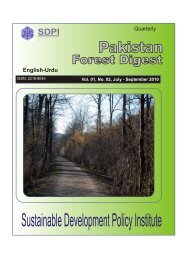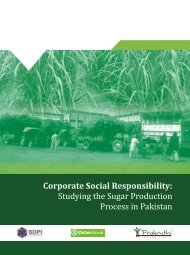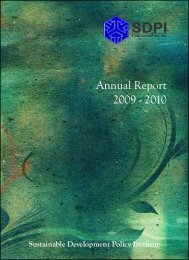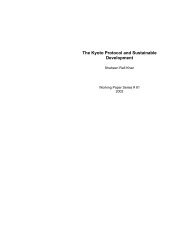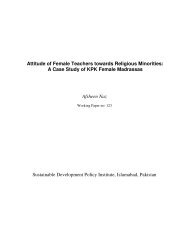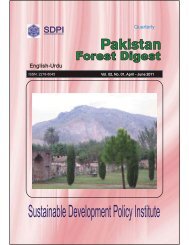April - June, 2010 - Sustainable Development Policy Institute
April - June, 2010 - Sustainable Development Policy Institute
April - June, 2010 - Sustainable Development Policy Institute
You also want an ePaper? Increase the reach of your titles
YUMPU automatically turns print PDFs into web optimized ePapers that Google loves.
SDPI<strong>Sustainable</strong> <strong>Development</strong> <strong>Policy</strong> <strong>Institute</strong>Chapter 06Orchards‘No botanical survey ever done in country’Dawn Islamabad, <strong>June</strong> 18, <strong>2010</strong>By Faiza IlyasKARACHI, <strong>June</strong> 17: Pakistan islosing its flora at an alarming rate.It has the second highest rate ofdeforestation in the world, andstudies suggest it would lose allnaturally grown trees within 15years if no mass-scaleconservation efforts were put inplace.The awareness of plantsignificance in government circlesmay be gauged from the fact thatthere is no department in thecountry that works for plantprotection. Hence, no botanicalsurvey has ever been carried out inthe country’s history.An authentic red data book onplants has never been producedand no importance has ever beenattached to plant conservationwhile declaring an area protected.These were some of the importantpoints highlighted by notedbotanist Prof Dr MohammadQaiser at a seminar onconservation of biodiversity heldin the arts auditorium of KarachiUniversity on Thursday.Dr Qaiser is the vice-chancellor ofthe Federal Urdu University forArts, Science and Technology andalso the co-editor of Flora ofPakistan. The book carryingscientific details of all theindigenous flowering plant speciesof the country is the firstcomprehensive work on thesubject.Giving his presentation on floraldiversity of Pakistan, Dr Qaisersaid the country blessed with someof the highest peaks in the world,glaciers and a 1,050-kilometrelongcoastline was a land ofcontrasts in many respects. Thisdiversity in geographicalconditions had given birth to ahuge variety in flora and fauna.A numerical analysis of Pakistan’sflora, he said, had shown that therewere 221 flowering families and5,700 flowering species. Of them,65 per cent families wererepresented by fewer than 10 percent species and about 405 specieswere endemic.“The country could be divided intofour regions according to thegeographic distribution of plantspecies of which the most rich interms of floral biodiversity is theIrano-Turanian region that includeGilgit-Baltistan, parts of Kashmir,Khyber Pakhtunkhwa andBalochistan. It has the bulk offloral species, that is, 45.6 per centof the total floral species,” he said.Referring to deforestation, he saidPakistan had the second highestrate of deforestation after Brazil inthe world and it was annuallylosing four to six per cent ofwoody biomass.“It is claimed that 4.5 to 4.7 percent of the total land mass in thecountry is covered by forests. Butthere is no ground survey tosupport that claim. Studies,however, suggest that Pakistanwith this current rate of forestdepletion would lose all itsnaturally grown trees in 10 to 15years,” he said.Regarding strategies for plantconservation, he said there was adire need to carry out a botanicalsurvey of the whole country todetermine the actual status of allplant species.“Priority should be given toendemic species in conservation.Researches have shown that amajority of the over 50 endemicspecies found in the northern areasand Sindh are criticallyendangered. There is a dire need toprotect these plants and carry outmonitoring of vegetation,” he said.No conservation effort, however,could be successful if localcommunities were not involvedand a sustainable solution to theirPakistan Forest Digest Vol. 1, No. 1, <strong>April</strong> – <strong>June</strong>, <strong>2010</strong>



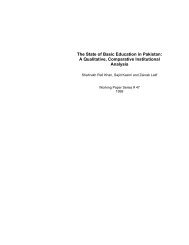
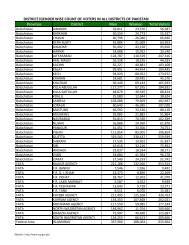
![(October - December, 2010) [13th SDC Special Bulletin]](https://img.yumpu.com/50118608/1/184x260/october-december-2010-13th-sdc-special-bulletin.jpg?quality=85)
